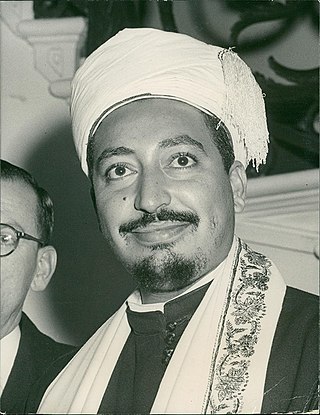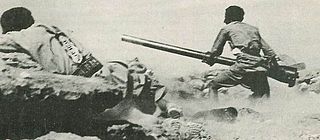
The history of Yemen describes the cultures, events, and peoples of what is one of the oldest centers of civilization in the Near East. Its relatively fertile land and adequate rainfall in a moister climate helped sustain a stable population, a feature recognized by the ancient Greek geographer Ptolemy, who described Yemen as Eudaimon Arabia meaning "fortunate Arabia" or "Happy Arabia". Yemenis had developed the South Arabian alphabet by the 12th to 8th centuries BC, which explains why most historians date all of the ancient Yemeni kingdoms to that era.

The Yemeni Armed Forces are the military forces of the Republic of Yemen. They include the Yemeni Army, Yemeni Navy and the Yemeni Air Force. The capital of the country, Sana’a is where the military is headquartered. Per the constitution of Yemen, the President of Yemen serves as the commander-in-chief.
Zaydism is one of the three main branches of Shia Islam that emerged in the eighth century following Zayd ibn Ali‘s unsuccessful rebellion against the Umayyad Caliphate. Zaydism is typically considered to be a branch of Shia Islam that comes closest to the Sunni, although the "classical" form of Zaydism over the centuries had changed its posture with regard to Sunni and Shia traditions multiple times, to the point where interpretation of Zaydi as Shia is often based on just their acceptance of Ali as a rightful successor to Muhammad. Zaydis regard the rationalism as more important than Quranic literalism and in the past were quite tolerant towards Sunni Shafiism, a religion of about half of the Yemenis.

Taiz is a city in southwestern Yemen. It is located in the Yemeni highlands, near the port city of Mocha on the Red Sea, at an elevation of about 1,400 metres (4,600 ft) above sea level. It is the capital of Taiz Governorate. As of 2023, the city has an estimated population of approximately 940,600 residents making it the third largest city in Yemen.

Yahya Muhammad Hamid ed-Din was the first king of the Mutawakkilite Kingdom of Yemen from 1918 until his assassination in 1948. He became Imam of the Zaydis in 1904 after the death of his father, Muhammad Al-Mansur, and Imam of Yemen in 1918. His name and title in full was "His majesty Amir al-Mumenin al-Mutawakkil 'Ala Allah Rab ul-Alamin Imam Yahya bin al-Mansur Bi'llah Muhammad Hamidaddin, Imam and Commander of the Faithful".

Muhammad Al-Badr was the last king and Zaidi Imam of the Mutawakkilite Kingdom of Yemen and leader of the monarchist regions during the North Yemen Civil War (1962–1970). His full name was Al-Mansur Bi'llah Muhammad Al-Badr bin Al-Nasir-li-dinu'llah Ahmad, Imam and Commander of the Faithful and King of the Mutawakkilite Kingdom of Yemen.

Ahmad bin Yahya Hamidaddin was the penultimate king of the Mutawakkilite Kingdom of Yemen, who reigned from 1948 to 1962. His full name and title was H.M. al-Nasir-li-Dinullah Ahmad bin al-Mutawakkil 'Alallah Yahya, Imam and Commander of the Faithful, and King of the Mutawakkilite Kingdom of the Yemen.

The Kingdom of Yemen, officially the Mutawakkilite Kingdom of Yemen, or simply as Yemen, or, retrospectively, as North Yemen, was a state that existed between 1918 and 1962 in the northwestern part of what is now Yemen. Located in the Middle East, the Kingdom of Yemen had an area of 195,000 km2. The country was bordered by Saudi Arabia in the north, and the Aden Protectorate to the south. Its capital was Sana'a from 1918 to 1948, then Taiz from 1948 to 1962. Yemen was admitted to the United Nations on 30 September 1947. From 1962 to 1970, it maintained control over portions of Yemen until its final defeat in the North Yemen Civil War.

The North Yemen Civil War was a civil war fought in North Yemen from 1962 to 1970 between partisans of the Mutawakkilite Kingdom and supporters of the Yemen Arab Republic. The war began with a coup d'état carried out in 1962 by revolutionary republicans led by the army under the command of Abdullah as-Sallal. He dethroned the newly crowned King and Imam Muhammad al-Badr and declared Yemen a republic under his presidency. His government abolished slavery in Yemen. The Imam escaped to the Saudi Arabian border where he rallied popular support from northern Shia tribes to retake power, and the conflict escalated rapidly to a full-scale civil war.
The modern history of Yemen began with the withdrawal of the Ottoman Empire. In 1839 the British set up a protective area around the southern port of Aden and in 1918 the northern Kingdom of Yemen gained independence from the Ottoman Empire. North Yemen became a republic in 1962, but it was not until 1967 that the British Empire withdrew from what became South Yemen. In 1970, the southern government adopted a communist governmental system. The two countries were formally united as the Republic of Yemen on May 22, 1990.

The Imams of Yemen and later also the Kings of Yemen were religiously consecrated leaders belonging to the Zaidiyyah branch of Shia Islam. They established a blend of religious and political rule in parts of Yemen from 897. Their imamate endured under varying circumstances until the republican revolution in 1962, then the formal abolition of the monarchy in 1970. Zaidiyyah theology differed from Ismailis or Twelver Shi'ites by stressing the presence of an active and visible imam as leader. The imam was expected to be knowledgeable in religious sciences, and to prove himself a worthy headman of the community, even in battle if this was necessary. A claimant of the imamate would proclaim a "call" (da'wa), and there were not infrequently more than one claimant. The historian Ibn Khaldun mentions the clan that usually provided the imams as the Banu Rassi or Rassids. In the original Arab sources the term Rassids is otherwise hardly used; in Western literature it usually refers to the Imams of the medieval period, up to the 16th century. The Rassid branch that came to power with imam al-Mansur al-Qasim is known as Qasimids.

The Imams of Yemen, later also titled the Kings of Yemen, were religiously consecrated leaders belonging to the Zaidiyyah branch of Shia Islam. They established a blend of religious and temporal-political rule in parts of Yemen from 897. Their imamate endured under varying circumstances until the end of the North Yemen Civil War in 1970, following the republican revolution in 1962. Zaidiyyah theology differs from Isma'ilism and Twelver Shi’ism by stressing the presence of an active and visible imam as leader. The imam was expected to be knowledgeable in religious scholarship, and to prove himself a worthy headman of the community, even in battle if this was necessary. A claimant of the imamate would proclaim a "call" (dawah), and there were not infrequently more than one claimant.

Abūʾl-Ḥusayn Yaḥyā ibn al-Ḥusayn ibn al-Qāsim ibn Ibrāhīm al-Ḥasanī, better known by his honorific title of al-Hādī ilāʾl-Ḥaqq, was a religious and political leader in the Arabian Peninsula. He was the first Zaydi imam who ruled portions of Yemen from 897 to 911. He is also the ancestor of the Rassid Dynasty which ruled Yemen intermittently until the North Yemen Civil War in 1962.
An-Nasir Muhammad bin Abdallah was an imam of part of the Zaidi state in Yemen, who ruled in 1217–1226 in rivalry with a contender.
Al-Mansur al-Hasan (1199–1271) was an imam of the Zaidi state of Yemen who ruled in 1262–1271.
The al-Waziri coup, also referred as the Yahya clan coup was a violent dynasty overthrow attempt in the Mutawakkilite Kingdom of Yemen in 1948, which caused around 5,000 fatalities. During the coup attempt, Imam Yahya Muhammad Hamid ed-Din, the ruler of the kingdom, was killed and the rival Sayyid family, the al-Wazirs, seized power for several weeks. Backed by the al-Saud family of Saudi Arabia, the Hamidaddins restored their rule. After the al-Wazirs were deposed, Imam Yahya's monarchy was restored with his son, Ahmad bin Yahya, ascending the throne.
The Free Yemeni Movement was a nationalist political movement active in the politics of North Yemen from the mid-1930s until the 1962 coup, which ushered in the Yemen Arab Republic and the eight-year North Yemen Civil War.
Major General Mohammed Abdullah Saleh Afash was the first Chief of Staff of the Yemeni Central Security Forces and one of its leaders and the brother of former Yemeni President Ali Abdullah Saleh Afash. He died on 14 May 2001 in London and his body was transferred to Sanaa.
Abd al-Was’i bin Yahya bin Hussein al-Wasa’i al-Yamani (May 1878 – January 1960) was a Muslim scholar, Zaidi jurist and Yemeni Islamic historian. He was born and raised in Sana'a. He received his knowledge there, then left for Mecca and took from its scholars. He made many trips, visiting most countries of the Islamic world, such as India, Iraq, Egypt, the Levant, and others. He was in Damascus when the First General War and the Battle of Damascus broke out, and he lived there for five years. Then he returned to his homeland and went on to teach at the Sana'a Mosque and at the Scientific School. He contributed to the publication of many Yemeni books and the definition of Yemen and its heritage, and he has many books, the most famous of which is "The History of Yemen, which is called The Reflection of Concerns and Sadness in Accidents and History of Yemen." Interested in the hadith and science of the calendar and Islamic history of Yemen. He died in his hometown at the age of 82.

Ahmad Yahya al-Thulaya was a Yemeni colonel who led the failed 1955 coup against Imam Ahmad bin Yahya, the absolute monarch of the Mutawakkilite Kingdom of Yemen.











